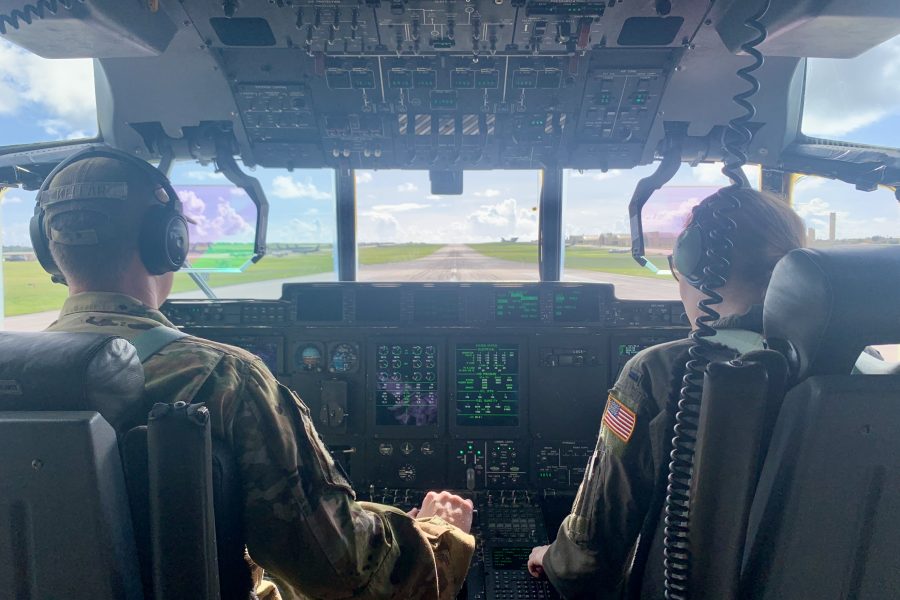ANTONIO B. WON PAT INTERNATIONAL AIRPORT, GUAM—Senior Master Sgt. Preston Kash climbed onto the flight deck of the C-130J transport plane, face dripping with sweat.
“I just need some air,” the bald mountain of a loadmaster said as he crossed the deck to one of the vents pumping A/C.
Kash had spent the past half hour breathing exhaust as he and several other Airmen used chains to tie down a 23,000-pound firetruck inside the C-130’s fuselage. The truck barely fit the 10-foot wide cargo bay, and its tires had to be partially deflated to clear the nine-foot-tall ceiling.
The truck’s rear-mounted engine had burped smoke as it backed up off the airfield asphalt and onto the aircraft, but the tight squeeze meant the smoke lingered inside the fuselage and set off the C-130’s fire alarm as Kash and the other Airmen tied the vehicle down.
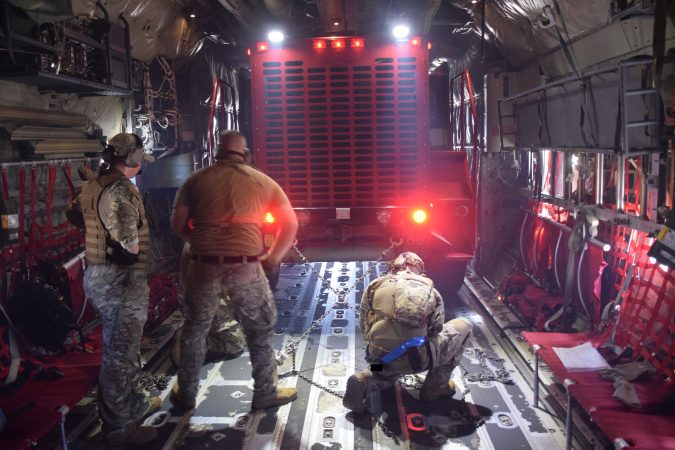
The midday tropical heat beat down on the metal tube and the aircraft’s four turbofan engines roared outside as the Airmen squeezed around the firetruck and crawled under its belly to set up a criss–crossing network of chains. They emerged with grease and sweat on their faces, eyes watering and throats burning from the smoke.
Loading the firetruck was just one moment in a busy day for the crew of tail number 05-3145. The two loadmasters and two pilots woke in their Guam hotel rooms before dawn on July 15, drove to Andersen Air Force Base for a pre–flight brief, then made their way to the aircraft for the long series of inspections, walkarounds, checklists, and good, old-fashioned standing around required before an 88,000-pound aircraft can get airborne.
The mission: haul cargo about 100 miles north to the small island of Tinian, then fly back to Guam’s civilian airport, pick up another load–including the firetruck, which ground crews needed for flightline safety–and fly it to Tinian, then come back to Andersen and call it a day. Four take–offs, four landings, and just two hours’ flying time.
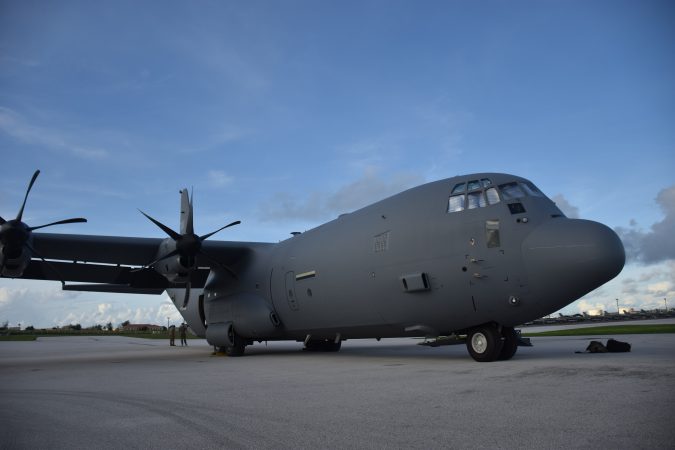
Those small hops are the C-130J Super Hercules’ specialty, but it took a 7,400-mile leap for Kash and the rest of the crew to get to Guam from their home station at Little Rock Air Force Base, Ark. They flew out here to take part in the Department-Level Exercise, a new wargame this summer where about 12,000 Airmen and Guardians practiced air combat, airlift, aerial refueling, aeromedical evacuation, and other missions across the Pacific.
In a future conflict, Air Force officials plan on launching aircraft from smaller, more dispersed airfields so that they are harder for enemy missiles to target. In the DLE, that meant Airmen worked from small airstrips like those on Tinian, without the support facilities they are used to at permanent Air Force bases. C-130 crews filled the gap, bringing troops the supplies and equipment they needed–including firetrucks–then packing up and taking it home when the job was done.
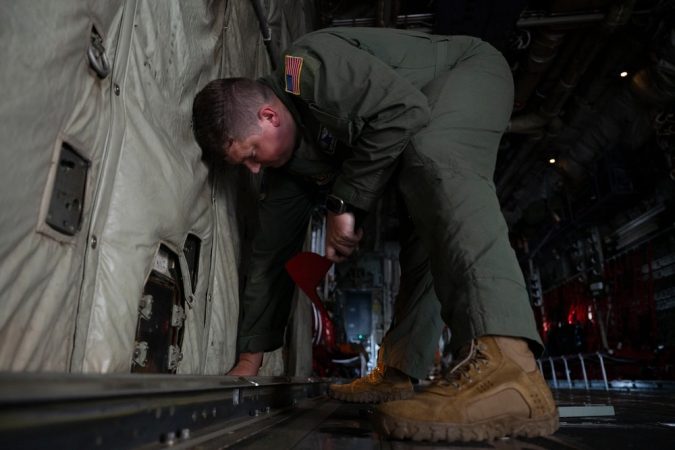
Kash’s fellow loadmaster, Senior Master Sgt. Mike Hopson, did a pre–flight inspection of the 20-year-old aircraft, looking for leaks, propeller damage, or anything else unusual. Beeps and boops sounded from the airplane’s PA as the pilots, Maj. Patrick Kellar and 1st Lt. Deborah Katvala, spun up the flight systems.
Hercules crews haul all kinds of cargo. Since arriving on Guam on July 10, 05-3145 moved everything from a spare C-130 engine to 12,000 pounds of palletized water bottles. In a future conflict, it could carry a 35,000-pound High Mobility Artillery Rocket System, just like the ones seeing extensive use in Ukraine.
This morning, a white pickup with the U.S. Department of Agriculture logo on its doors parked next to the C-130. Two men got out carrying a cardboard box marked “CONTENTS: POTATOES AND FEED BLOCKS FOR BROWN TREESNAKE TRAPS.” The traps surrounding the Tinian airfield to prevent the spread of the invasive treesnake needed refilling, so Hopson and Kash dutifully strapped the cardboard box down to the metal deck.
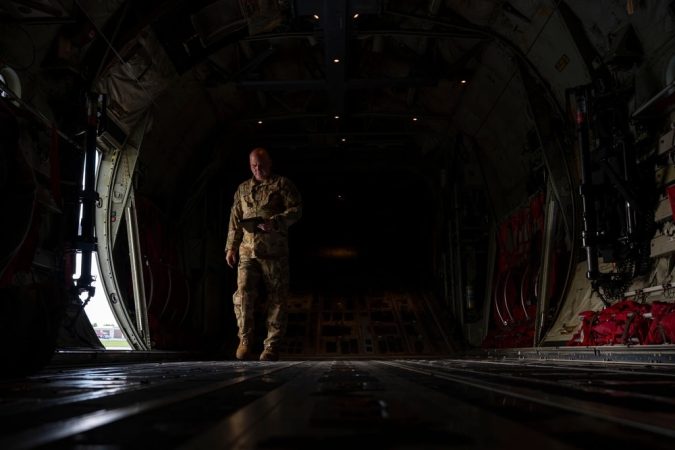
But really, the main event for this first sortie was an 8,000-pound STARCART refueling system hitched to the back of a pickup truck.
Hopson and Kash spent the night before studying the loading instructions produced by the Air Transportability Test Loading Activity, an Ohio-based agency that figures out how to safely load and tie down cargo onto Air Force aircraft. But the STARCART which showed up that morning was a different version from what they’d studied the night before.
A less experienced crew may have turned away the equipment, but Hopson and Kash, like many of their colleagues in the Air Force Reserve, had the reps to make it happen.
“As you grow in your career, your safety bubble gets a little bit bigger, so you can send it and know it’s not going to hurt anything,” Hopson explained.
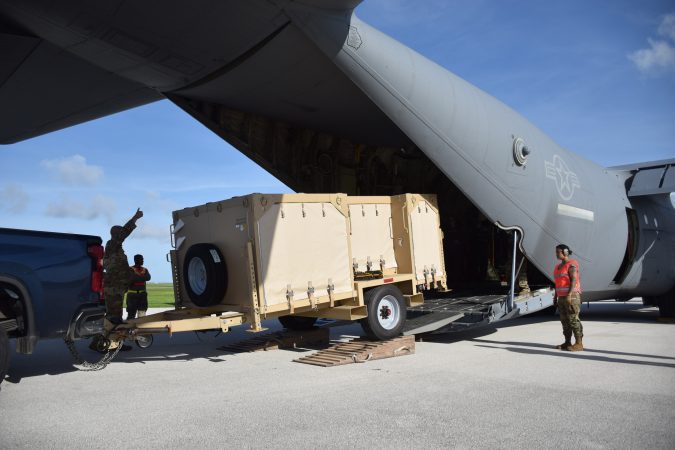
The same could not be said for the truck driver, who was driving cargo up the ramp of an aircraft for the first time. He later said it was not fun, and few could blame him: backing up delicate, expensive equipment at the exact right angle onto two narrow wooden planks, then up two equally narrow steel ramps into the bay of an expensive aircraft, all while being watched by your peers and two loadmasters you just met is no easy task. The whole process took about 45 minutes.
“If I was the dude driving that truck, I would have had just as much of an issue,” Hopson said.
By 8:52 a.m., the C-130 was finally flying north over the rippling blue tablecloth of the Pacific. The flight deck was stuffed with backpacks, reflective sun shades, and coolers, from which the loadmasters broke out small boxes of Little Caesars pizza topped with sausage and pepperoni. They had time for only a few bites before the aircraft touched down at Tinian’s airport after a 27-minute flight.
The pilots kept the engines running while Airmen usually stationed in Alaska climbed aboard to help undo the chains on the STARCART and back an all-terrain forklift deep into the C-130 to drag out the equipment. A man in a polo marked “Customs Biosecurity” carried off the box of potatoes. By 9:58 a.m., the C-130 was back in the air; it had taken less time to fly to Tinian and unload the cargo than it had to put the STARCART on the aircraft in the first place.
Tail 05-3145 never flew much higher than 6,000 feet all day, a change of pace for copilot 1st Lt Deborah Katvala, who in her civilian career flies Boeing 767 widebody passenger jets for a major airline. Many pilots start in the military and then get an airline job, but Katvala did the opposite: she started with the airlines and then joined the Air Force Reserve because she wanted to serve her country, and she specifically chose the Hercules because she liked its tactical mission set.
By 10:28 a.m., the C-130 was back on Guam, this time at Antonio B. Won Pat International Airport, to pick up the firetruck. Unlike the STARCART, the truck matched the ATTLA loading instructions that Kash and Hopson studied the night before. Kash directed the driver and got the truck in the aircraft at the right angle on the first shot, which was “like hitting a home run,” he said.
Then the chains came out: 14 chains rated to secure 10,000 pounds each, plus another two 25,000-pound chains. Air Force loadmasters tie down cargo as if it were three times as heavy, to account for three times the force of gravity should the pilots have to pull Gs in maneuvers.
“If you think you’ve got enough, throw two more chains on,” Hopson said.
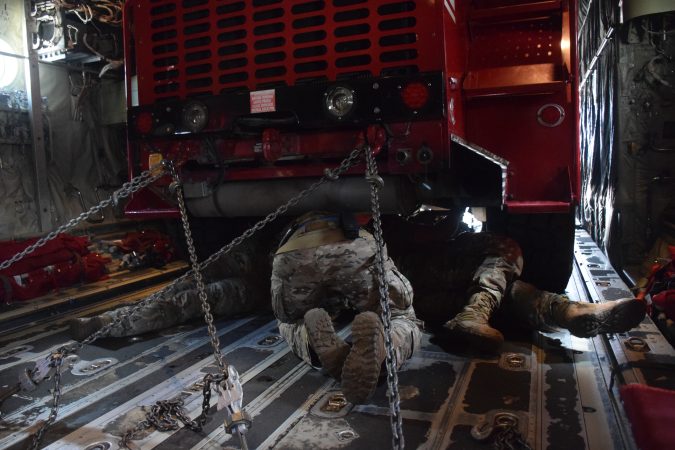
It took about a half hour of sweaty, smoky work to complete the tiedown, but by 11:42 the aircraft was in the sky again and heading back to Tinian.
The fact that heavier aircraft need more runway to stop is not a comforting thought on final approach into Tinian, which from the flight deck looks like a thin sliver of land sandwiched into endless water. But Kellar and Katvala brought the aircraft down without a hitch and soon 05-3145 was pulling back into the same parking spot it had left about two hours earlier.
The ground crews came back on board, the chains came down, and the truck drove off the ramp just 10 minutes after touchdown. Hopson and Kash coiled the chains in metal boxes near the rear of the fuselage, and in another 20 minutes the C-130 was airborne again, with the unburdened bird clearing the ground almost instantly after starting down the runway.

The sky was clear and the sun bright as 05-3145 made its last flight of the day. Katvala took a slice of Little Caesars from one of the coolers. Then the plane was descending back into Andersen. The crew landed at 1:18 p.m. and taxied down the runway past F-35s, F-22s, other C-130s, and even a few RQ-4 reconnaissance drones, before finally pulling onto the hardstand they had left that morning.
The pilots shut down the aircraft and the crew remembered what the world sounds like without four engines running in their ears. Crew chiefs came aboard to roll up headphone wires and straps and cover the engine intakes to keep out debris. A lavatory service truck pulled up and an Airman in a white hazmat suit prepared the small toilet at the back of the Hercules for another day of work–an unenviable task in the tropical humidity.
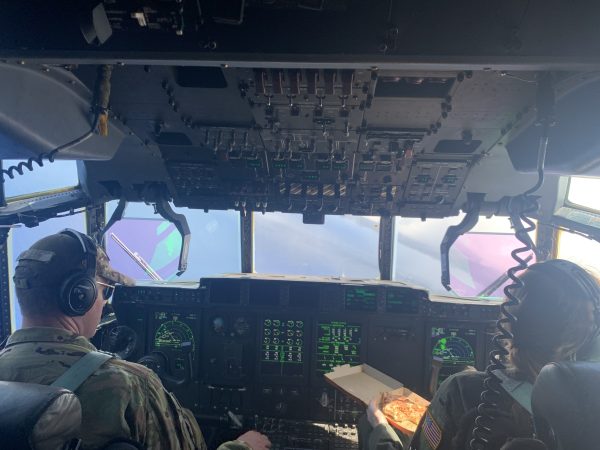
The four-sortie day was mild compared to ones planned with six or seven, Kellar said. Next week promised parachute drops with the Army, which would involve large formations of aircraft, detailed coordination with other services, and packing, weighing, and inspecting all the paratroopers’ gear and parachutes, just like they did with the firetruck.
Beyond that, maybe the C-130 crew would drop rafts and supplies into the ocean for a simulated downed pilot who they would have to find themselves, a task they can’t train for in landlocked Arkansas.
The early morning, the long STARCART load, the smoky firetruck, and the heat did not faze Hopson, who by the end of the day said he was tired but feeling great. On one hand, the mission was another long day on the job. But on the other hand, the temporary duty travel, or TDY is a chance to do it in a new place with new people.
“I’m always excited to be out here on TDYs,” he said.
